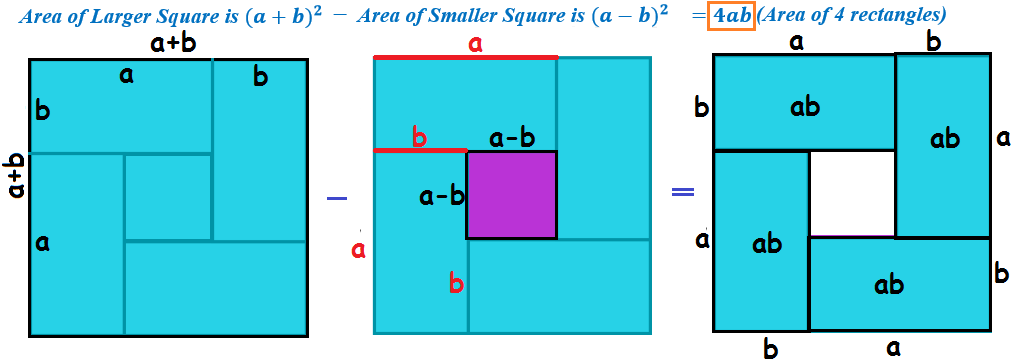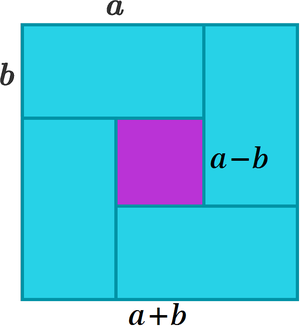Rectangles and Squares
Each turquoise rectangle has dimensions of a × b .
What is ( a + b ) 2 − ( a − b ) 2 ?
This section requires Javascript.
You are seeing this because something didn't load right. We suggest you, (a) try
refreshing the page, (b) enabling javascript if it is disabled on your browser and,
finally, (c)
loading the
non-javascript version of this page
. We're sorry about the hassle.
12 solutions

Moderator note:
In our subscriber courses we have a new quiz at our Algebra Through Puzzles exploration which approaches the difference of squares formula with these kind of visuals, plus videos. (Link to content.) A sample video illustrating ( x + y ) 2 is below.
I did it this way too but the solution is simpler with algebra and without the diagram
I did the same thing too but you can also shift around the parts to see that the side length of the purple square is b. (I hope I explained that correctly)
Log in to reply
Side length of purple square is a-b. Since each rectangle has dimensions axb where 'a' is the length and 'b' is the width. Please check the second diagram lines marked in the red color with the length 'a' and width 'b', from the red line markings side length of purple square a-b got derived.
The answer could be made even simpler. The equation and square in the middle are distractions. You have 4 rectangles. 4 * rectangle Rectangle is the same as a * b or ab. Rectangle = ab. 4 * rectangle is the same as 4 * ab or 4ab. I have 4 ab(s) = I have 4 rectangle(s).
I got distracted and got the answer wrong. Now I see it and it's nice to be reminded of the algebra.
Algebraically, by difference of squares, ( a + b ) 2 − ( a − b ) 2 = ( ( a + b ) + ( a − b ) ) ( ( a + b ) − ( a − b ) ) = ( 2 a ) ( 2 b ) = 4 a b .
Visually, ( a + b ) 2 represents the whole square, ( a − b ) 2 represents the middle purple square, and so its difference is represented by the four a × b turquoise rectangles with an area of 4 a b .
The confusing party to me is the way theproblem is set up. I don't understand why the sign in the middle of each side is not "-".
Without the aid of the given figure, we can use algebra by simply expanding and simplifying.
( a + b ) 2 − ( a − b ) 2
Expand the terms inside the parenthesis then collect like terms.
Expanding, we get
a 2 + 2 a b + b 2 − ( a 2 − 2 a b + b 2 )
Apply distributive property to remove the parenthesis. We get
a 2 + 2 a b + b 2 − a 2 + 2 a b − b 2
Collect like terms, we get
a 2 − a 2 + b 2 − b 2 + 2 a b + 2 a b = 4 a b
thats the reason 83% of us got it right, including me. we are into formulas, but fail to understand the beauty of the structure which portrays the idea so eloquently.
Log in to reply
Yeah.That's absolutely true.But how do we solve this by not using the formula?I mean,after you found out that, (a+b)^2 - (a-b)^2 = The area of the 4 rectangles, you need to expand it using the formula to get 4ab.
Log in to reply
i think its suffice to know the formula for the area of the rectangle( in this case 4 rectangles with sides a & b). you need not know (a+b)^2 or (a-b)^2. BTW there's nothing wrong in knowing the formulaes. But, our minds tend to forget things which are not portrayed visually. if we were given this kind of visual representation during our learning curve, we would have never hiccuped. i had trouble identifying the sides of the inner square because i am not into visual representation. if i could visualize the inner rectangle's area as (a-b)^2 as instantly as the outside rectangle's area, i could solve without knowing the expansion for the square of sum of two numbers or the difference of two numbers. I could do answer with the area of by substraction(visually) of two squares with embedded rectangles between them. what do u think?
Log in to reply
@Drought Rws&S – Yeah.That's sort of true,if you are looking at the problem visually/conceptually.But here,we do need a specific mathematical answer ,an expression as given in the options. So, while I appreciate your opinion to solve this more logically, I must also emphasize here that to get the correct option among the given options in the question,you must know basic algebraic formula.
That is the best way
Obviously I need to relearn alegebra
I also need to learn algebra? I have forgotten rules.
I basically just guess 4ab because I think it best fits the problem
Log in to reply
Exactly! The answer is 4 rectangles. 1 rectangle = ab. 4*ab
How did you get 2ab?
Log in to reply
(a+b)^2 = (a+b)(a+b) 1st: a a = a^2 2nd: a b = ab 3rd: b a = about ab + ab = 2ab TADA! 4th: b b = b^2 Put it all together a^2 + 2ab +b^2
The square in the middle is just by squared. So it should be a-b squared minus by squared.... Am I wrong?
looking at ( a + b ) 2 − ( a − b ) 2 the area of the outside square is ( a + b ) 2 and the area of the purple square is ( a − b ) 2 . subtracting these two areas leaves us with the area of the four turquoise rectangles which can be expressed as 4 a b .
( a + b ) 2 − ( a − b ) 2 =
a 2 + 2 a b + b 2 − ( a 2 − 2 a b + b 2 ) =
a 2 − a 2 + b 2 − b 2 + 2 a b + 2 a b = 4 a b

We note that the big square has a side length of a + b and hence an area of ( a + b ) 2 . And the small purple square has a side length of a − b and hence an area of ( a − b ) 2 . Therefore, ( a + b ) 2 − ( a − b ) 2 = the area of 4 blue turquoise rectangle 4 a b .
By looking at the picture we can say that for the outer square each side is a + b . So area of outer square is :
( a + b ) 2 = a 2 + b 2 + 2 a b
For, the purple square length of each side = a − 2 b = a − b . So, the are of purple square is :
( a − b ) 2 = a 2 + b 2 − 2 a b
Now, we have to find ( a + b ) 2 − ( a − b ) 2
⟹ a 2 + b 2 + 2 a b − ( a 2 + b 2 − 2 a b
⟹ a 2 + b 2 + 2 a b − a 2 − b 2 + 2 a b
⟹ 4 a b
So, we are left only with 4 a b which is the area of the four turquoise rectangles.
Theoretically speaking, by applying the formula of area of rectangle we will get 4 a b . The four rectangles are equal and length of each rectangle is a and breadth of each rectangle is b .
Area of one rectangle is a b . So the area of 4 rectangles is 4 a b . This is the result we got above.
Larger square minus the small purple square leaves the four a*b rectangles
We can solve it algebricaly (a+b)^2 -(a-b)^2=???
(a+b)^2=a^2+2ab+b^2
(a-b)^2=a^2-2ab+b^2
(a+b)^2-(a-b)^2=a^2+2ab+b^2-a^2+2ab-b^2
(a+b)^2-(a-b)^2=4ab
At first, we drew a diagram and calculated the area of the whole square which was (a+b)^2 . Then, we figured out the area of the smaller square which was (a-b)^2 . We said that (a+b)^2 - (a-b)^2 must equal the are of the four rectangles on the outside which was 4ab .
However one can recognise the elementary identity (a+b)^2-(a-b)^2=4ab
First ( a + b ) 2 = a 2 + 2 a b + b 2 .Next ( a − b ) 2 = a 2 − 2 a b + b 2 So ( a + b ) 2 − ( a − b ) 2 = a 2 + 2 a b + b 2 − a 2 − 2 a b + b 2 = ( a 2 − a 2 ) + ( 2 a b − − 2 a b ) + ( b 2 − b 2 ) = 4 a b